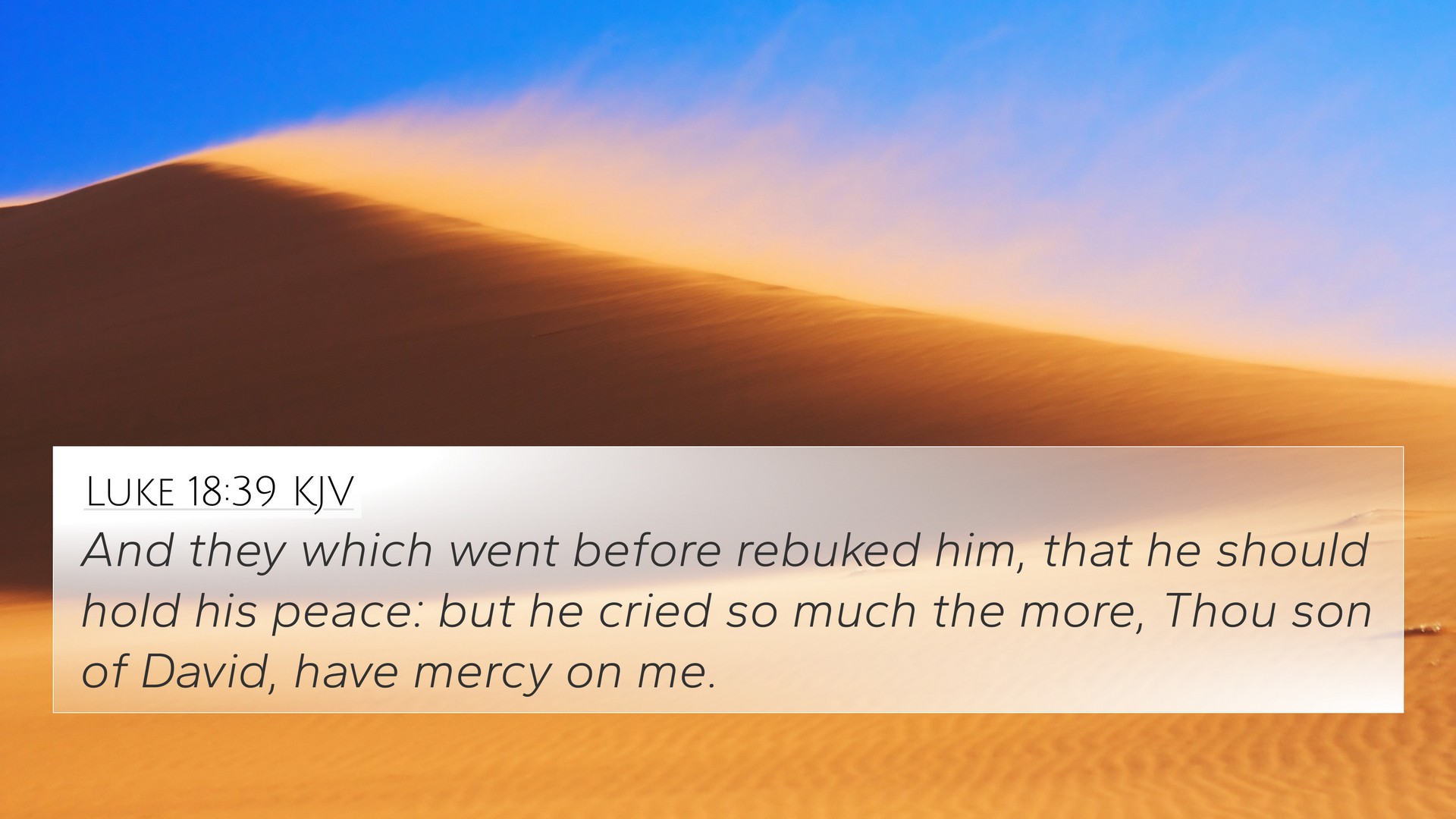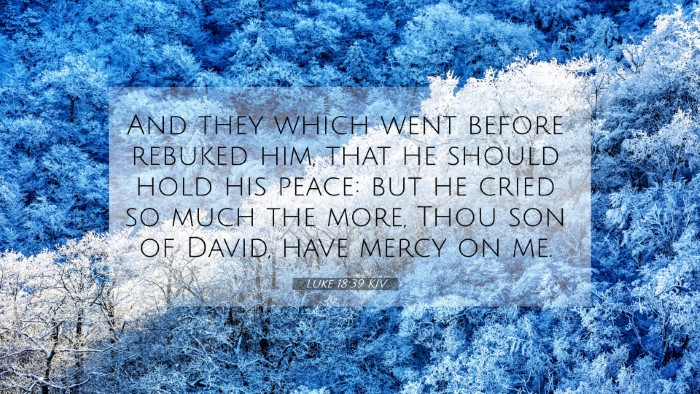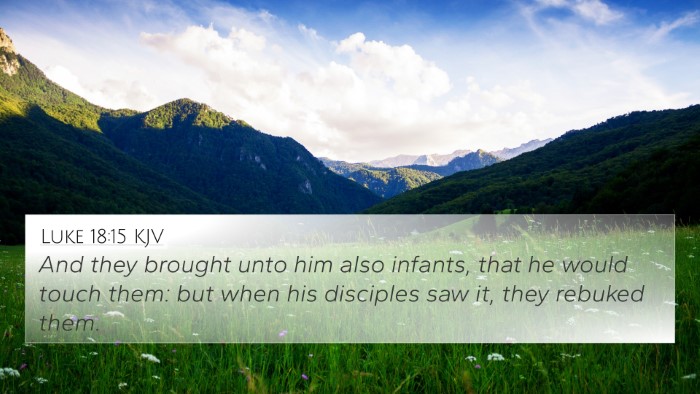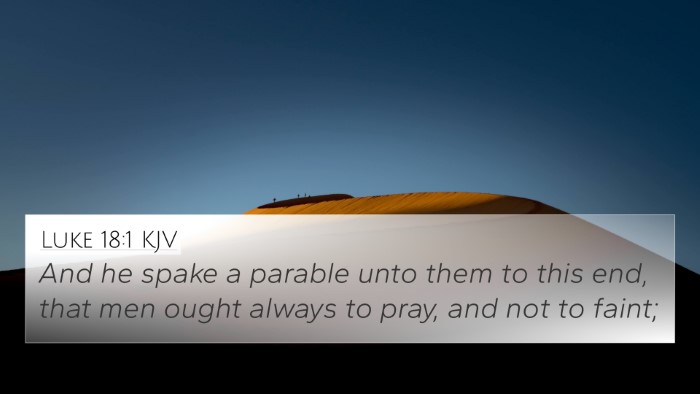Understanding Luke 18:39
Luke 18:39 captures a significant moment in the New Testament where the urgency of faith and the recognition of Jesus' power is displayed. The verse states: “And they which went before rebuked him, that he should hold his peace: but he cried so much the more, Thou Son of David, have mercy on me.”
Summarized Meaning and Insights
This verse is a powerful testament to faith in the face of adversity. The blind man, despite being rebuked, persistently calls out for Jesus' mercy, showing a deep understanding of Jesus' identity as the “Son of David,” which acknowledges Jesus as the Messiah. The following insights combine the perspectives of reputable public domain commentaries.
Matthew Henry's Commentary
Matthew Henry emphasizes the determination of the blind man, portraying his faith as an example of persistent prayer. He notes that the response of the crowd, rebuking the man, illustrates the disdain some have towards fervent requests for Jesus' intervention. This pushback did not deter the blind man's faith, highlighting the importance of perseverance in seeking God's mercy.
Albert Barnes' Commentary
Barnes points out the significance of the title “Son of David” used by the blind man. This reference is not only a request for healing but also a declaration of faith in Jesus' authority as the promised Messiah. Barnes suggests that the realization of one’s neediness is essential for approaching Christ, as evident in the blind man's desperate plea.
Adam Clarke's Commentary
Clarke elaborates on the cultural context of the rebuke. He indicates that crowd dynamics often pressure individuals to conform, yet the blind man's refusal to be silenced by the crowd displays a profound courage. Clarke encourages readers to recognize their own desperate need for Christ’s mercy, as evident in the blind man's loud cry for help.
Bible Verse Cross-References
- Matthew 20:30-34: This passage recounts a similar story of two blind men calling out to Jesus for mercy, emphasizing the necessity of faith and persistence.
- Mark 10:46-52: The story of Bartimaeus, who similarly calls out to Jesus and is ultimately healed, mirrors the determination seen in Luke 18:39.
- Isaiah 35:5-6: A prophecy regarding the coming of the Messiah who will heal the blind, connecting the Old Testament promise with New Testament fulfillment.
- Luke 18:1: The preceding verse introduces the theme of persistent prayer, which is exemplified through the blind man’s desperate cry.
- James 5:16: The power of fervent prayer is highlighted, which aligns with the blind man's unwavering request for healing.
- Romans 10:13: “For whosoever shall call upon the name of the Lord shall be saved,” reflects the key principle of invoking Jesus' name for mercy.
- Psalm 34:6: “This poor man cried, and the Lord heard him,” resonates with the blind man's experience in Luke 18:39 where desperation leads to divine attention.
- Luke 7:12-15: The account of Jesus raising the widow's son illustrates His authority over life and death, similar to His compassionate reaction to the blind man's plea.
- Matthew 9:27: The healing of two blind men who also recognized Jesus as the Messiah underscores the theme of faith in His divine compassion.
Thematic Connections between Bible Verses
In examining Luke 18:39, one notices multiple thematic connections that enhance understanding:
- Faith in Adversity: The blind man’s tenacity in the face of opposition invites believers to reflect on their own efforts in seeking Christ despite societal pressures.
- Recognition of Jesus’ Authority: Referring to Jesus as the “Son of David” ties into messianic prophecies, revealing the blind man's understanding of Jesus' true identity.
- Power of Persistent Prayer: The narrative encourages persistent prayer, a theme echoed throughout the Gospels, reminding believers of the importance of not losing heart.
Comparative Analysis of the Gospels
Cross-referencing related verses across Matthew, Mark, and Luke offers a comprehensive view of the blind man's healing narratives. The similarities reinforce the significance of faith and highlight differing aspects of Jesus' ministry. This examination serves as a practical tool for Biblical study, allowing readers to engage with the layered context of healing stories in the New Testament.
Tools for Bible Cross-Referencing
For deeper study and exploration, consider the use of Bible concordances and cross-reference guides. These resources assist in navigating links between verses, providing context and enhancing understanding of thematic connections within Scripture.
Overall, Luke 18:39 encapsulates the essence of faith, the importance of recognizing Jesus’ identity as a healer and Savior, and the necessity of unyielding persistence in prayer. This message resonates throughout Scripture, found expressed in various forms, encouraging believers to deepen their faith and understanding through cross-referencing and thematic analysis.















